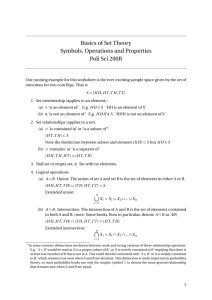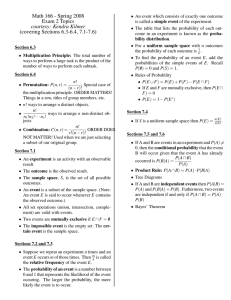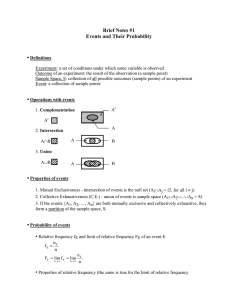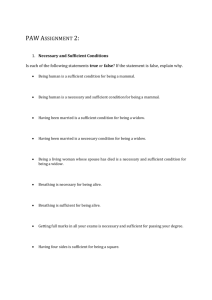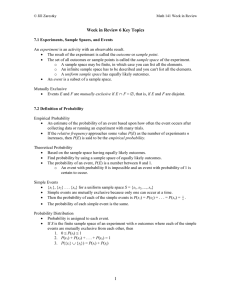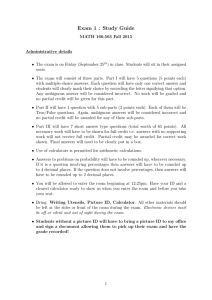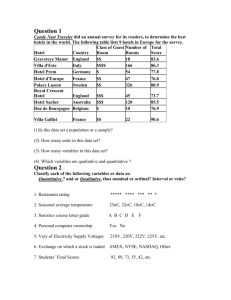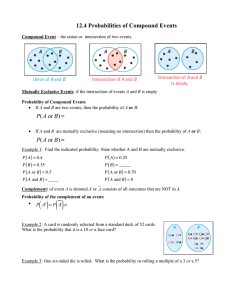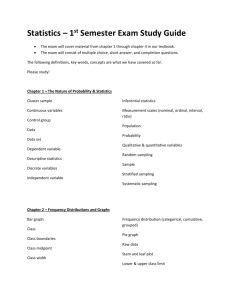Fundamental Concepts
advertisement
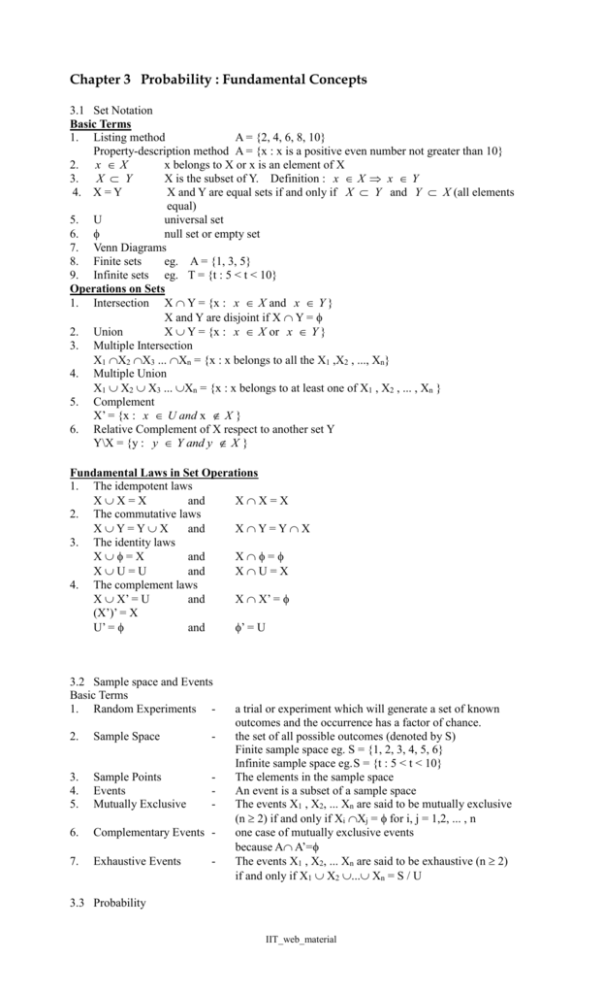
Chapter 3 Probability : Fundamental Concepts
3.1 Set Notation
Basic Terms
1. Listing method
A = {2, 4, 6, 8, 10}
Property-description method A = {x : x is a positive even number not greater than 10}
2. x X
x belongs to X or x is an element of X
3.
X is the subset of Y. Definition : x X x Y
X Y
4. X = Y
X and Y are equal sets if and only if X Y and Y X (all elements
equal)
5. U
universal set
6.
null set or empty set
7. Venn Diagrams
8. Finite sets
eg. A = {1, 3, 5}
9. Infinite sets eg. T = {t : 5 < t < 10}
Operations on Sets
1. Intersection X Y = {x : x X and x Y }
X and Y are disjoint if X Y =
2. Union
X Y = {x : x X or x Y }
3. Multiple Intersection
X1 X2 X3 ... Xn = {x : x belongs to all the X1 ,X2 , ..., Xn}
4. Multiple Union
X1 X2 X3 ... Xn = {x : x belongs to at least one of X1 , X2 , ... , Xn }
5. Complement
X’ = {x : x U and x X }
6. Relative Complement of X respect to another set Y
Y\X = {y : y Y and y X }
Fundamental Laws in Set Operations
1. The idempotent laws
XX=X
and
XX=X
2. The commutative laws
XY=YX
and
XY=YX
3. The identity laws
X=X
and
X=
XU=U
and
XU=X
4. The complement laws
X X’ = U
and
X X’ =
(X’)’ = X
U’ =
and
’ = U
3.2 Sample space and Events
Basic Terms
1. Random Experiments 2.
Sample Space
-
3.
4.
5.
Sample Points
Events
Mutually Exclusive
-
6.
Complementary Events -
7.
Exhaustive Events
-
a trial or experiment which will generate a set of known
outcomes and the occurrence has a factor of chance.
the set of all possible outcomes (denoted by S)
Finite sample space eg. S = {1, 2, 3, 4, 5, 6}
Infinite sample space eg. S = {t : 5 < t < 10}
The elements in the sample space
An event is a subset of a sample space
The events X1 , X2, ... Xn are said to be mutually exclusive
(n 2) if and only if Xi Xj = for i, j = 1,2, ... , n
one case of mutually exclusive events
because A A’=
The events X1 , X2, ... Xn are said to be exhaustive (n 2)
if and only if X1 X2 ... Xn = S / U
3.3 Probability
IIT_web_material
1.
Classical Definition of Probability
n ( A)
P(A) =
n(A) is the number of sample points of event A
n(S )
n(S) is the number of sample points of the sample space
2.
Relative Frequency Definition of Probability
n
P(A) =
N is the number of trials
N
n is the number of times that event A occur
** N is very large/ N **
Some Properties of Probability
For any event A in S
(1) 0 P(A) 1
(2) P(S)=1
(3) If A and B are mutually exclusive events in S. then
P(AB) = P(A) + P(B)
(4) If A and B are exhaustive events
P(AB) = 1
(5) P(impossible events) = 0
(6) P(certain event) = 1
(7) P(A’) = 1 - P(A)
3.
3.4
Methods of Counting
1.
2.
Total no No. of objects
of objects taken at a time
n
n
n
r
Remarks
No. of permutation
all distinct
all distinct
n!
3.
n
n
k kinds
n1 , n2 , n3 ,... nk
4.
n
n
circular permutation
IIT_web_material
n!
(n r )!
n!
n1 ! n2 !... n k !
(n-1)!
Prn
